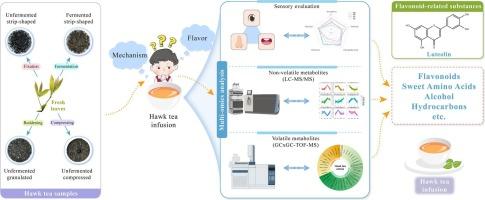Examining the effects of processing techniques on the quality of hawk tea through liquid chromatography–tandem mass spectrometry and two-dimensional gas chromatography–time-of-flight mass spectrometry
IF 9.8
1区 农林科学
Q1 CHEMISTRY, APPLIED
引用次数: 0
Abstract
Processing techniques are critical factors influencing the quality of hawk tea, yet systematic studies on their effects are limited. This study investigates the impact of four key processing procedures—fixation, reddening, fermentation, and compressing—using sensory evaluation, LC-MS/MS, and GC × GC-TOF-MS. Analysis identified 6951 non-volatile metabolites, including 107 marker metabolites, primarily in flavonoid synthesis and degradation pathways. Fermentation increased sweetness and richness by enhancing sugars and amino acid content, while significantly reducing flavonoid levels. Reddening improved flavor, color, and retained more beneficial flavonoids. Volatile analysis detected over 1800 compounds, including 398 volatile marker metabolites. Fermentation increased alcohols and heterocyclic compounds, reducing hydrocarbons and ketones. Additionally, 26 camphoraceous and 12 pungent aroma compounds characteristic of hawk tea were identified, and an aroma-flavor correlation map was established. By elucidating the impact of processing methods on its chemical and sensory properties, this study lays the groundwork for targeted quality control of hawk tea.


通过液相色谱-串联质谱法和二维气相色谱-飞行时间质谱法研究加工工艺对鹰茶品质的影响
加工技术是影响鹰茶品质的关键因素,但对其影响的系统研究却很有限。本研究采用感官评价、LC-MS/MS 和 GC × GC-TOF-MS 等方法,调查了四种关键加工程序--固定、变红、发酵和压缩--的影响。分析确定了 6951 种非挥发性代谢物,包括 107 种标记代谢物,主要是黄酮类化合物的合成和降解途径。发酵提高了糖和氨基酸的含量,从而增加了甜度和丰富度,同时显著降低了类黄酮的含量。变红改善了风味和色泽,并保留了更多有益的类黄酮。挥发性分析检测出 1800 多种化合物,包括 398 种挥发性标记代谢物。发酵增加了醇和杂环化合物,减少了碳氢化合物和酮。此外,还发现了 26 种樟脑和 12 种刺激性香气化合物,并建立了鹰茶的香气-味道相关图谱。通过阐明加工方法对鹰茶化学和感官特性的影响,该研究为有针对性地控制鹰茶质量奠定了基础。
本文章由计算机程序翻译,如有差异,请以英文原文为准。
求助全文
约1分钟内获得全文
求助全文
来源期刊

Food Chemistry
工程技术-食品科技
CiteScore
16.30
自引率
10.20%
发文量
3130
审稿时长
122 days
期刊介绍:
Food Chemistry publishes original research papers dealing with the advancement of the chemistry and biochemistry of foods or the analytical methods/ approach used. All papers should focus on the novelty of the research carried out.
 求助内容:
求助内容: 应助结果提醒方式:
应助结果提醒方式:


